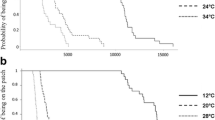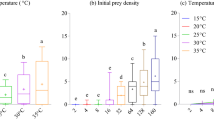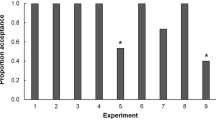Abstract
The functional response ofTelenomus reynoldsi Gordh & Coker was determined at 5 constant temperatures using a dish arena. Functional response curves at all temperatures were of Holling's Type II. Handling rate increased linearly with increasing temperature, whereas the relationship of search rate to temperature was best described by a quadratic model. Search rate was highest at 32°C. Using Rogers' random parasite equation, analysis of the functional response in a more complex arena containing an artificial plant provided estimates of search and handling rates that may be more appropriate in the field environment. Search rate was 6,680 cm2/day. Handling rate was 13 hosts/day.
Résumé
La réponse fonctionnelle deTelenomus reynoldsi Gordh et Coker à l'augmentation de la densité des œufs deGeocoris punctipes (Say) a été déterminée à 5 températures constantes en utilisant des boîtes de Pétri. Les courbes obtenues à toutes les températures étaient de Type II. Les durées du parasitisme (Th) et les taux de recherche de l'hôte (a) ont été estimés et comparés en utilisant l'équation «disc» de Holling. Le taux maximum du parasitisme (1/Th) s'est accru linéairement de 9 à 15 hôtes/jour avec l'accroissement de la température. La meilleure représentation de la relation entre le taux de recherche de l'hôte et la température a été obtenue par une équation quadratique. Le taux de recherche de l'hôte variait de 205 à 888 cm2/jour; il était maximum à 32° C.
En utilisant l'équation du «random parasite» (parasite recherchant son hôte au hasard), l'analyse de la réponse fonctionnelle dans un terrain plus complexe contenant une plante artificielle, a conduit à des estimations plus précises du taux de recherche de l'hôte et du taux maximum du parasitisme, qui peuvent être utilisées pour décrire ces activités dans la nature. Le taux de la recherche de l'hôte était de 6680 cm2/jour, tandis que le taux maximum du parasitisme était de 13 hôtes/jour.
Similar content being viewed by others
References
Barnett, T. — Effects of temperature and host density on the rate of increase of an insect parasite. —Am. Nat., 85, 337–352.
Barnett, T. — 1954. Influences of natural temperatures and controlled host densities on oviposition of an insect parasite. —Physiol. Zool., 27, 239–248.
Cave, R. D. & Gaylor, M. J. — 1989. Parasitism ofGeocoris [Het.: Lygaeidae] eggs byTelenomus reynoldsi [Hym.: Scelionidae] andTrichogramma pretiosum [Hym.: Trichogrammatidae] in Alabama. —Environ. Entomol., (in press.).
Cave, R. D., Gaylor, M. J. &Bradley, J. T. — 1987. Host handling and recognition byTelenomus reynoldsi [Hym.: Scelionidae], an egg parasitoid ofGeocoris spp. [Het.: Lygaeidae]. —Ann. Entomol. Soc. Am., 80, 217–223.
Coker, R. A. — 1973. The bionomics ofGeocoris pallens Stål andGeocoris punctipes (Say) in cotton-alfalfa agroecosystems with special reference to the biology ofTelenomus reynoldsi, sp. n., a primary parasite ofGeocoris eggs. —PhD dissertation, University of California, Riverside.
Everson, P. — 1980. The relative activity and functional response ofPhytoseiulus persimilis [Acari.: phytoseiidae] andTetranychus urticae [Acari.: Tetranychidae]: The effect of temperature. —Can. Entomol., 112, 17–24.
Fedorenko, A. Y. — 1975. Feeding characteristics and predation impact ofChaoborus [Dipt.: Chaoboridae] larvae in a small lake. —Limnol. Oceanogr., 20, 250–258.
Feliciangeli, D. &Rabinovich, J. E. — 1985. Parasitism ofTelenomus costalimai [Hym.: Scelionidae] onRhodnius prolixus [Hem.: Reduviidae] under laboratory conditions: Effects of density. —J. Med. Entomol., 22, 654–657.
Frazer, B. D. &Gilbert, N. — 1976. Coccinellids and aphids: A quantitative study of the impact of adult ladybirds [Col.: Coccinellidae] preying on field populations of pea aphids [Hom.: Aphididae]. —J. Entomol. Sci. B. C., 73, 33–56.
Hassell, M. P. — 1978. The dynamics of arthropod predator-prey systems. —Monogr. Popul. Biol., 13,Princeton Univ. Princeton, N. J.
Holling, C. S. — 1959a. The components of predation as revealed by a study of small mammal predation of the European pine sawfly. —Can. Entomol., 91, 293–320.
Holling, C. S. — 1959b. Some characteristics of simple types of predation and parasitism. —Can. Entomol., 91, 385–398.
Livdahl, T. P. — 1979. Evolution of handling time: The functional response of a predator to the density of sympatric and allopatric strains of prey. —Evolution, 33, 765–768.
Livdahl, T. P. &Stiven, A. E. — 1983. Statistical difficulties in the analysis of predator functional response data. —Can. Entomol., 115, 1365–1370.
Mack, T. P., Bajusz, B. A., Nolan, E. S. &Smilowitz, Z. — 1981. Development of a temperaturemediated functional response equation. —Environ. Entomol., 10, 573–579.
Mack, T. P. &Smilowitz, Z. — 1982. Using temperature-mediated functional response models to predict the impact ofColeomegilla maculata (DeGeer) adults and 3rd-instar larvae on green peach aphids. —Environ. Entomol., 11, 46–52.
McCaffrey, J. P. &Horsburgh, R. L. — 1986. Functional response ofOrius insidiosus [Hem.: Anthocoridae] to the European red mite,Panonychus ulmi [Acari: Tetranychidae], at different constant temperatures. —Environ. Entomol., 15, 532–535.
Messenger, P. S. — 1968. Bioclimatic studies of the aphid parasitePraon exsoletum. 1. Effects of temperature on the functional response of females to varying host densities. —Can. Entomol., 100, 728–741.
Rogers, D. — 1972. Random search and insect population models. —J. Anim. Ecol., 41, 369–383.
SAS Institute, Inc. — 1982. SAS user's guide: Statistics, 1982 ed. —SAS Institute, Inc., Cary, N. C.
Shapiro, S. S. &Wilk, M. B. — 1965. An analysis of variance test for normality (complete samples). —Biometrika, 52, 591–611.
Surber, D. E., Fye, R. E., Bonham, C. D. & Owens, C. D. — 1974. Surface area of Deltapine Smoothleaf, Hopicala, and Pima S-2 cotton plants. —USDA, ARS W-20.
Thompson, D. J. — 1978. Towards a realistic predator-prey model: The effect of temperature on the functional response and life history of larvae of the damselfly,Ischnura elegans. —J. Anim. Ecol., 47, 757–767.
Author information
Authors and Affiliations
Rights and permissions
About this article
Cite this article
Cave, R.D., Gaylor, M.J. Functional response ofTelenomus reynoldsi [Hym.: Scelionidae] at five constant temperatures and in an artificial plant arena. Entomophaga 34, 3–10 (1989). https://doi.org/10.1007/BF02372581
Received:
Accepted:
Issue Date:
DOI: https://doi.org/10.1007/BF02372581




